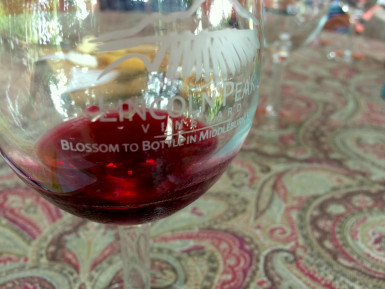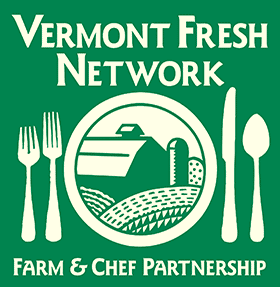Lincoln Peak Tour for Restaurant Staff - August 13th
 July 9, 2018
July 9, 2018
Lincoln Peak Winery Tour
Monday, August 13th - 1:00 - 3:00pm
142 River Road, New Haven VT
Lincoln Peak is an award winning winery that uses only grapes grown on their estate, with over 12 acres in production. They are known for their La Crescent and Marquette wines, and are one of the Vermont wineries establishing our state’s reputation for exceptional Marquettes. Their crisp white wine Black Sparrow (Louise Swenson, Prairie Star, and Adalmiina) is a popular menu feature, and is even on draft at Bar Antidote in Vergennes.
In this visit you will learn about their winemaking process, growing grapes in Vermont, tasting notes for their wines, and more about the story of Vermont wine. You’ll have a chance to talk with winemaker Chris Granstrom about opportunities and challenges in selling more Vermont wine at Vermont restaurants.
This trip has already happened, find the notes below.
Read this earlier profile of winemaker Chris Granstrom on the DigInVT blog. Read about other activities in the wine project here.
The Vermont Fresh Network Wine Project is offered in collaboration with the Vermont Grape and Wine Council. Read about all of our wine-related activities on the Wine Project page at VermontFresh.net.
This project was supported by the U.S. Department of Agriculture’s (USDA) Agricultural Marketing Service through grant 16-SCBGP-VT-0005. Its contents are solely the responsibility of the authors and do not necessarily represent the official views of the USDA.

Chris Granstrom began Lincoln Peak Vineyard in New Haven, VT, as a strawberry farm in 1981, then started planting grape vines as an experiment and for a time was the largest grape producer in Vermont. In 2006 Lincoln Peak was one of the first growers to cultivate the Marquette grape - which we now see as a foundation for many Vermont reds. Wine making stemmed from the grape growing, and in 2008 Lincoln Peak opened a tasting room, and when they began producing more than could be sold through the tasting room they connected with G. Hausen (and then Farrell) to begin distribution.
Lincoln Peak still has a popular tasting room, where visitors can make an “event” out of visiting a vineyard, tasting the wines, sampling some cheese, sitting on the porch, in summer there are also concerts. This setting lends itself to consumers trying new things, since it’s only a taste and the mood is one of exploration. Vermont’s higher price point can also be more acceptable in the context of a wine-focused afternoon’s entertainment, and it’s not being compared to other glasses on a menu. About 75% of Lincoln Peak’s sales go through the tasting room plus events like the farmers market and Cheese Festival. Almost all the rest happens through Farrell (a few restaurants want direct sales). There’s some restaurant overlap, Chris does hear from customers who are visiting because they saw the wine on the menu the night before.
- We’ve known that tasting rooms are a good venue for engaging customers. Vermont Wine Week experimented some with how to recreate elements of this in a restaurant setting. Having a winemaker at the restaurant offering samples and available to talk about the wine, plus a special or two on the menu that featured the wines in a pairing, seemed most promising.
Chris notes there are a lot of barriers to entry in Vermont wine compared to other beverages because you’re running the farm, on soil where grape growing is labor intensive (we have too much fertility, there’s a lot of pruning and untangling and managing the vines), with processing also on site, and often you are running a retail store as well. Plus wine takes a really long time to develop - you can’t tweak it every few weeks, most versions of wine take time to be ready and you harvest the grapes once a year. It requires years of work to have consistent high quality wines. Marquette didn’t even exist until 2006; we’ve really just hit our stride now.
Specific challenges to restaurant sales are familiar from previous discussions (see our original report here). Some items we highlighted:
- Unfamiliar grapes - Chris believes we should talk about Vermont grapes not in comparison to other grapes, and that we need to educate full restaurant staffs on our grapes to be sure the information gets conveyed to consumers.
- History of uneven quality in the Vermont wine market - and wineries today still do not cooperate much on quality control, on working together to learn high quality. This barrier is something we did an extended session on in December with an outline of an approach Cornell developed for peer-based quality management.
- Price point
- Individual relationships with restaurants help - occasionally there will be a staff field trip to the vineyard to learn about the wines.
Lincoln Peak Vineyard is known for its work with Marquette grapes, the “classic” Vermont wine grape, which the University of Minnesota introduced in 2006. Chris is currently playing with less oak in Marquette red, which he believes helps highlight its darker fruit nuances. Their crisp Black Sparrow white wine (a blend of Louise Swenson, Prairie Star, and Adalmiina) is often found on the menu at restaurants that carry Vermont wine.
We also explored some less well known options in the Lincoln Peak library:
- Nouveau-style Marquette - aka Thanksgiving Wine (Beaujolais Nouveau is released on the third Thursday in November after a few weeks of fermentation). Raise your hand if you think Lincoln Peak should release a magnum of Nouveau-style Marquette on Thanksgiving and give us a new holiday tradition. At least one person wants this.
- Starlight Rosé - okay, this is a very popular wine at Lincoln Peak so not exactly “less well known”, but it reinforces the rosé fixation that still holds American consumers in thrall and how our wineries have responded. We also discussed the complementary trend of using leftover wine skins for rosé-ing other products, like cider.
- Firelight (a dessert wine that is not a true ice wine, but behaves similarly) and Cassis (currant-based dessert wine) - dessert wines are the original gluten free dessert. Adding some flourless chocolate cake would be gilding the lily but delicious. At the VFN Annual Forum dinner we also explored how sweeter wines & ciders can fit in other places on the menu, they often work alongside savory options. We talked about presenting this style of beverage as relates to Ice Cider ahead of our winter trip to Eden Specialty Ciders, see the post here.
- Ragtime White - speaking of sweeter wines, why exactly do we let people dismiss sweeter white wines? We’re not talking dessert wines or cloying wines, but a lovely sweeter La Crescent like Ragtime White. It’s a perfect complement to strong flavors - Vermont cheese, for example, or generously spiced dishes like you would find at the popular Honey Road restaurant (that’s a hint, Honey Road). Also a good base for wine cocktails. No more with turning our nose up at sweet whites, they deserve a place on the sophisticated diner’s table.

The winery and vineyard tours don’t end here, next up is a visit to Shelburne Vineyard to talk about their new more experimental Iapetus line. Email zea@vermontfresh.net to be on the list to learn more.

